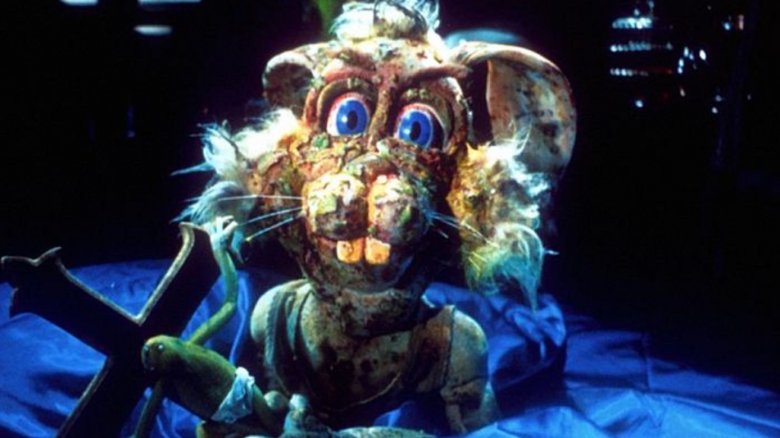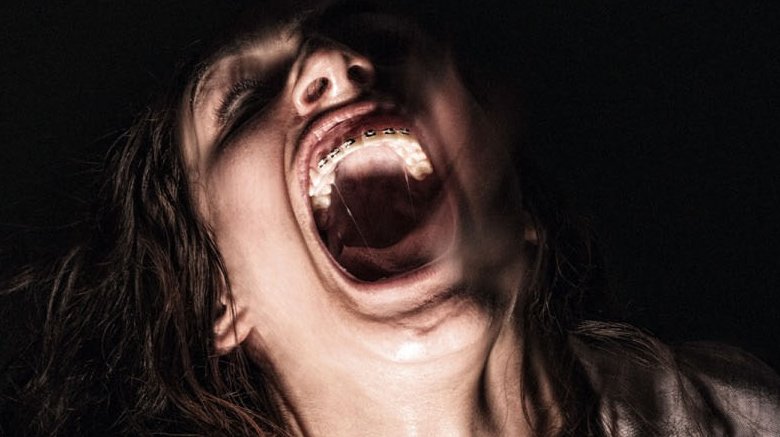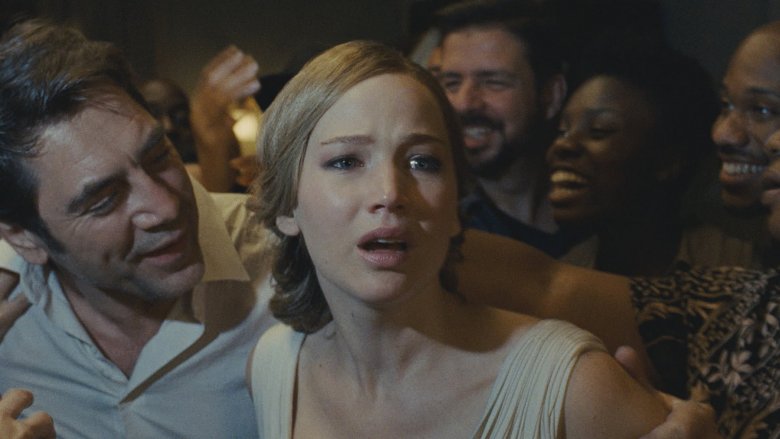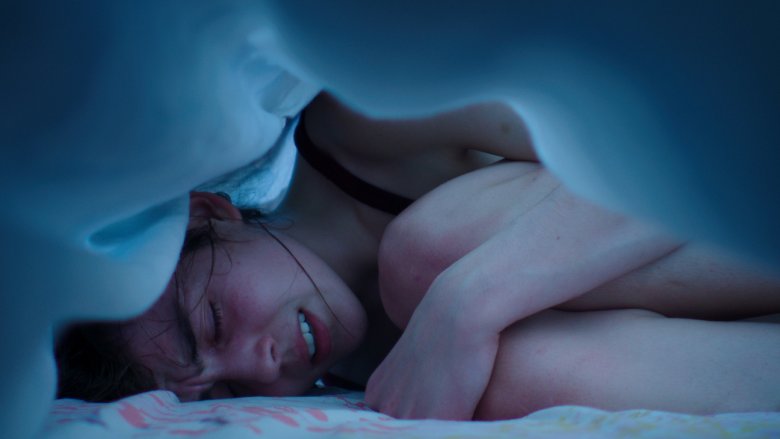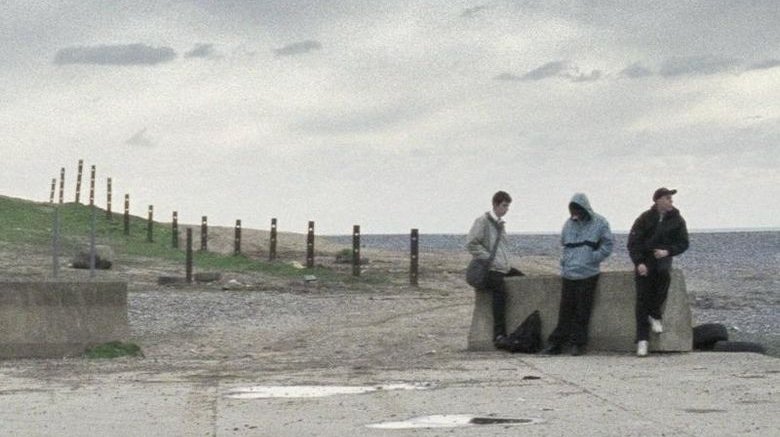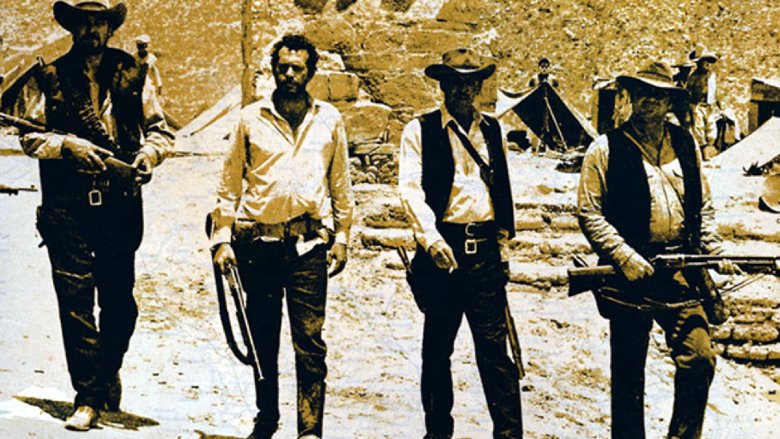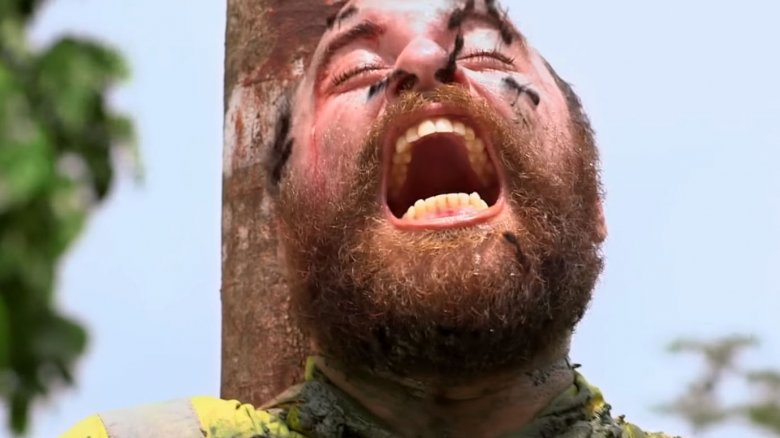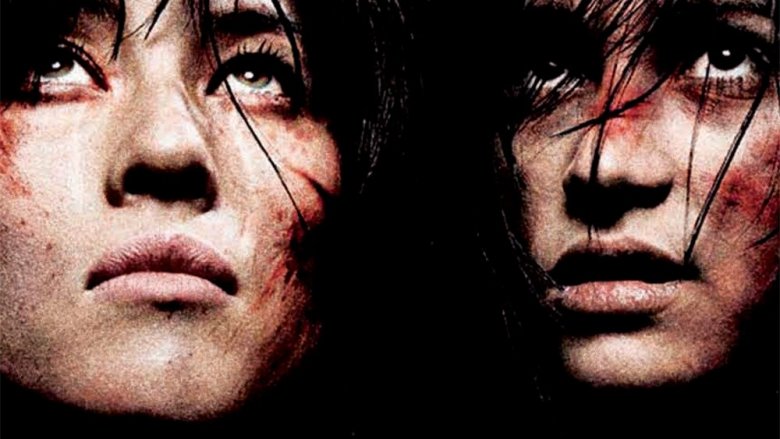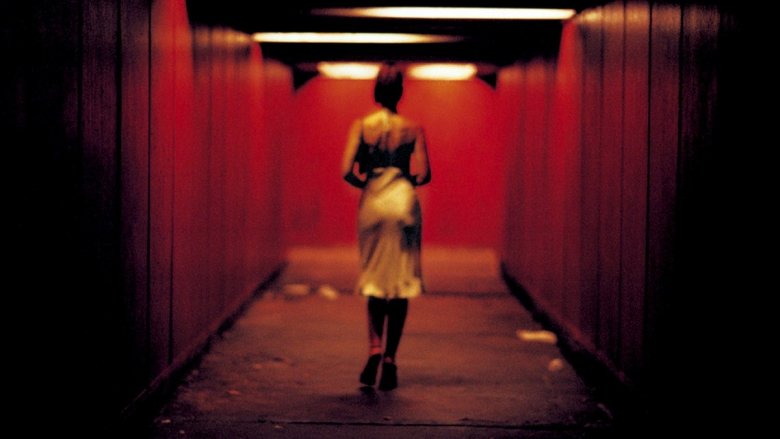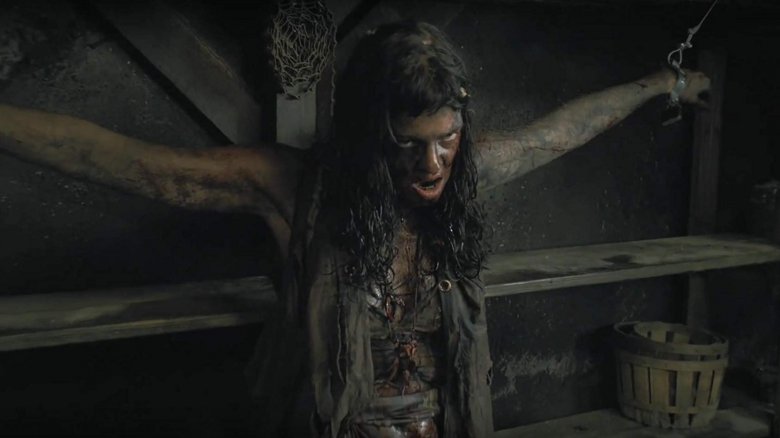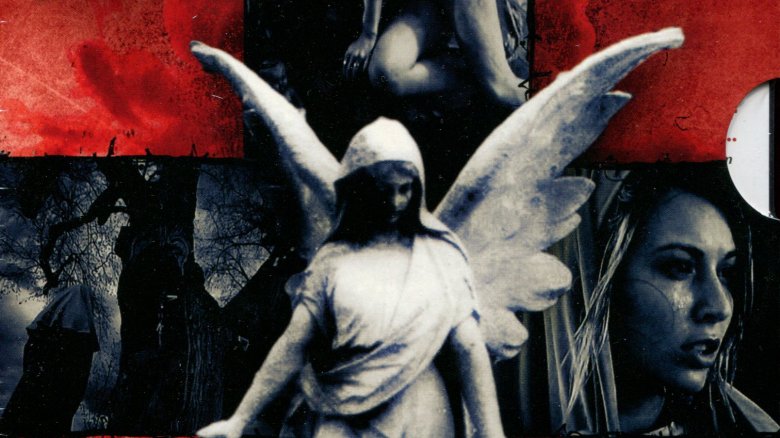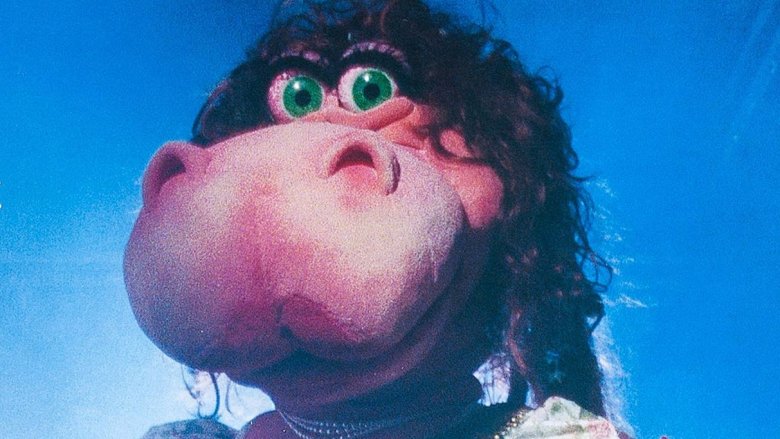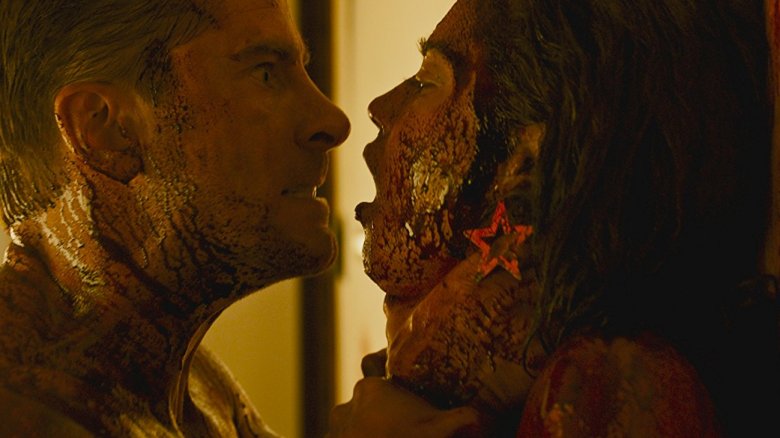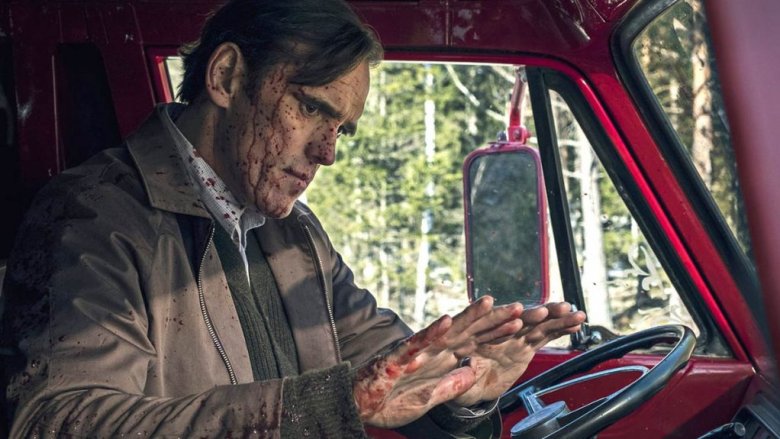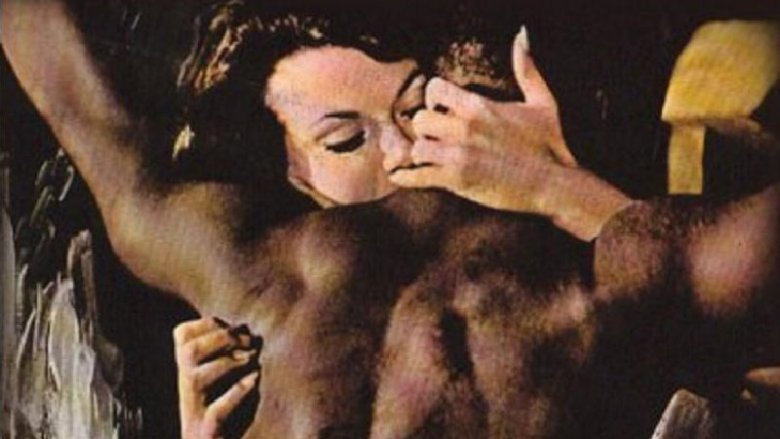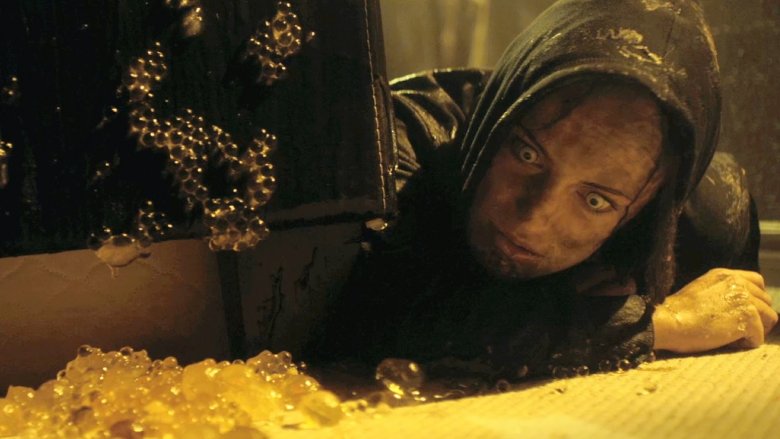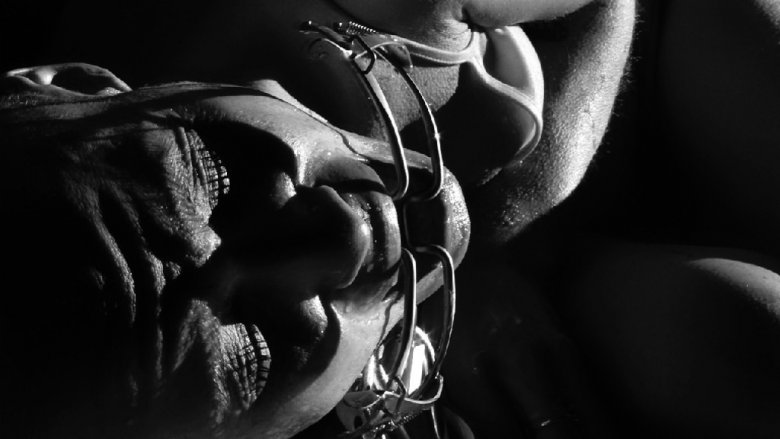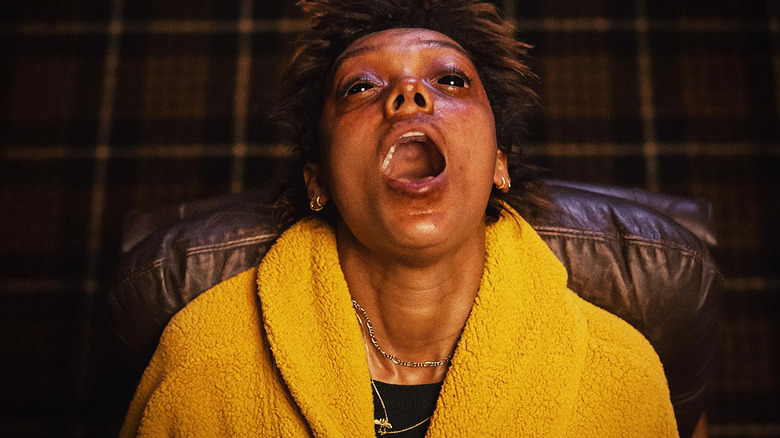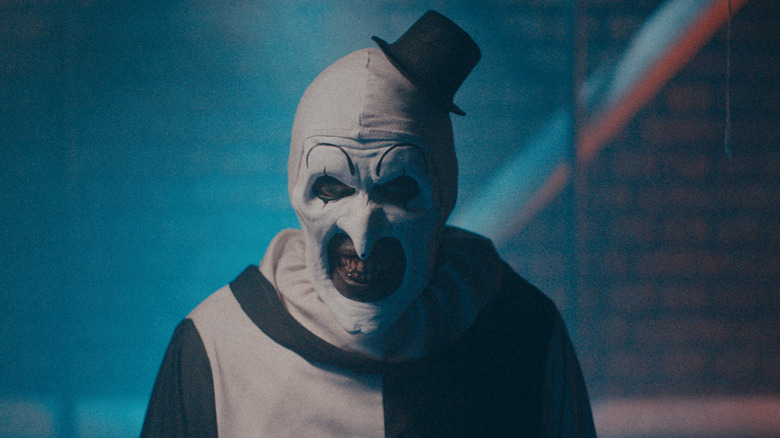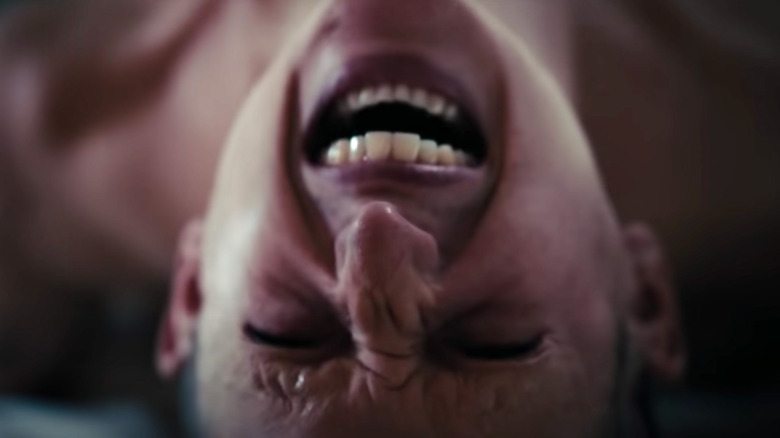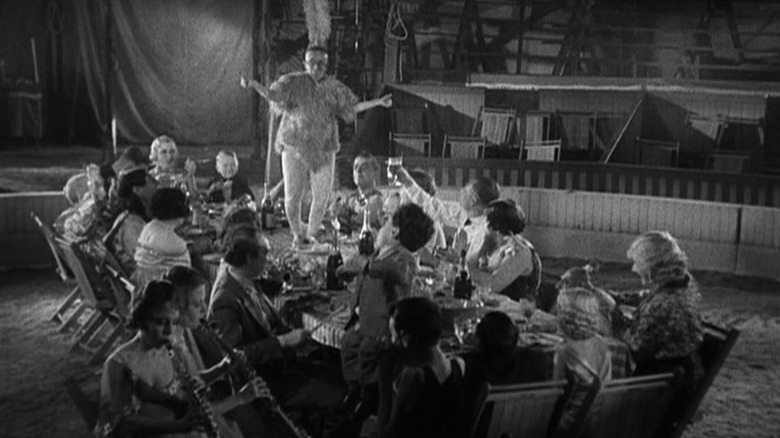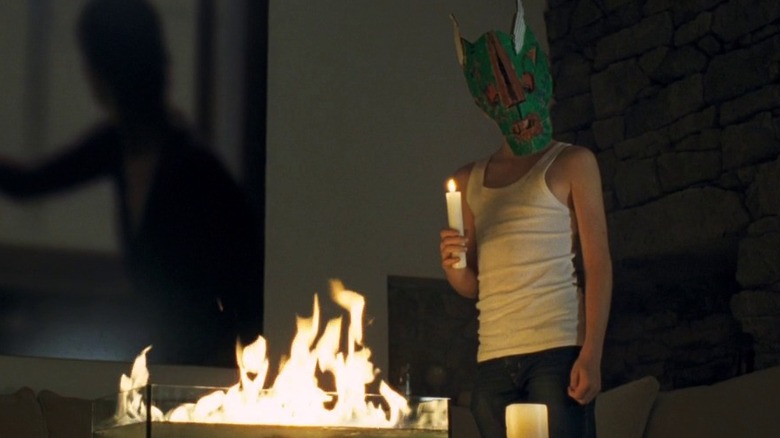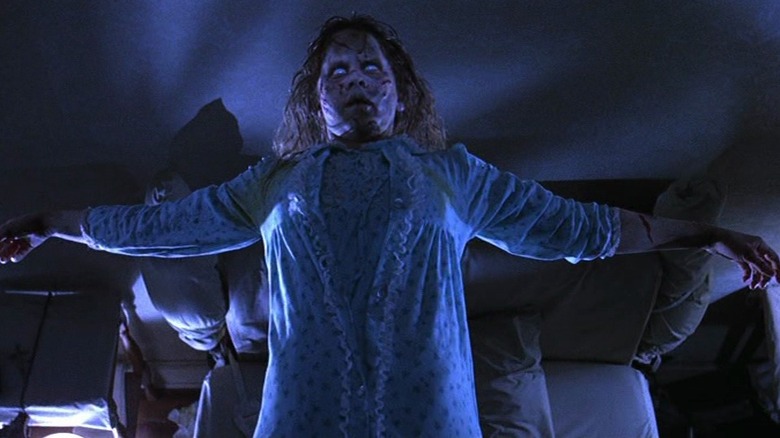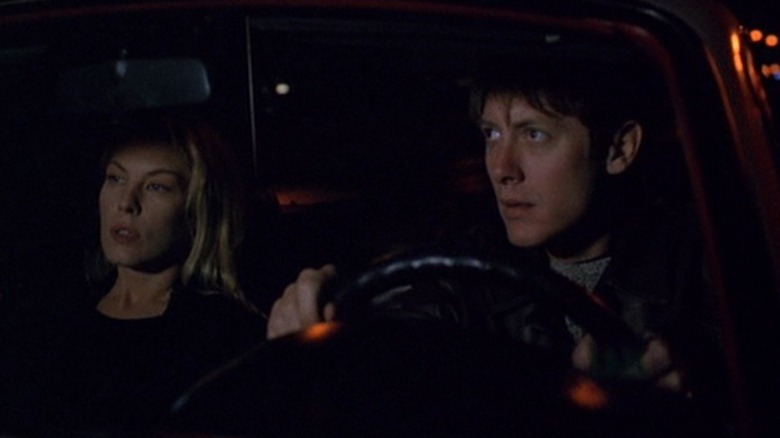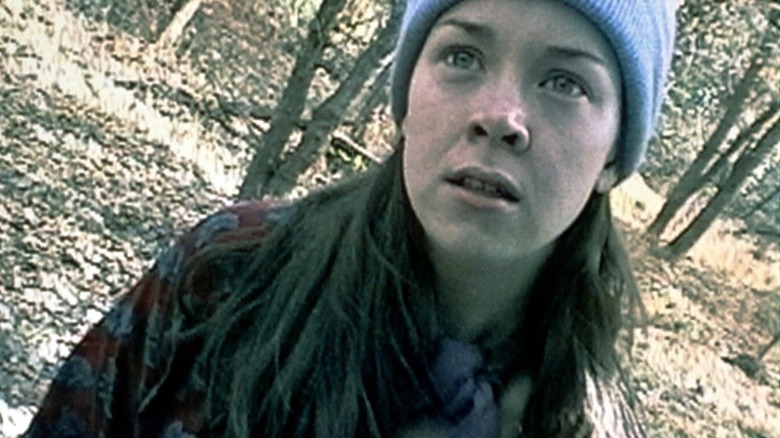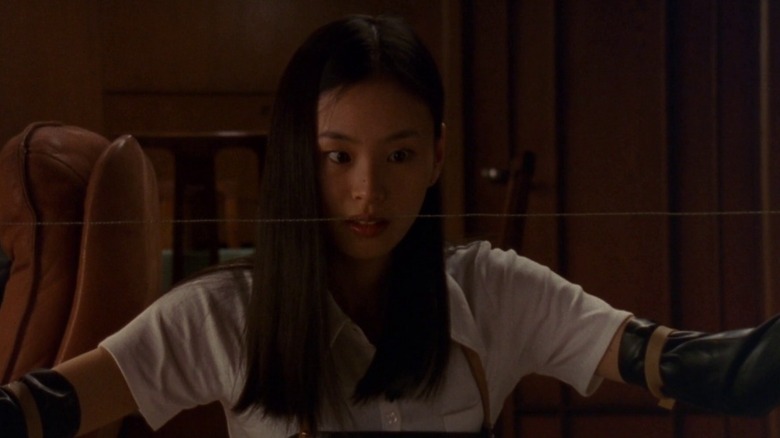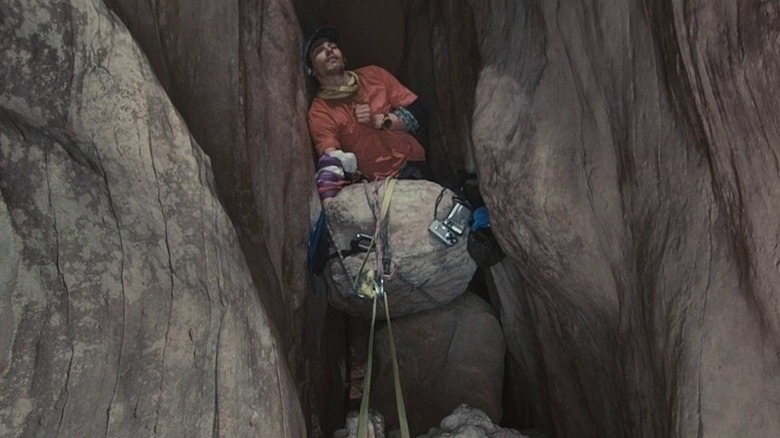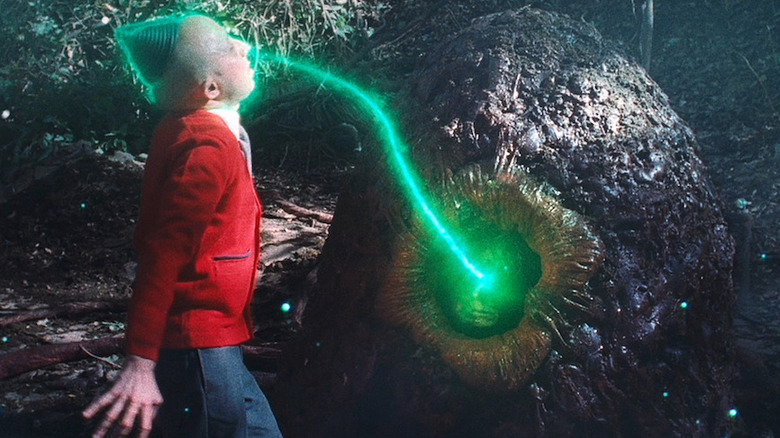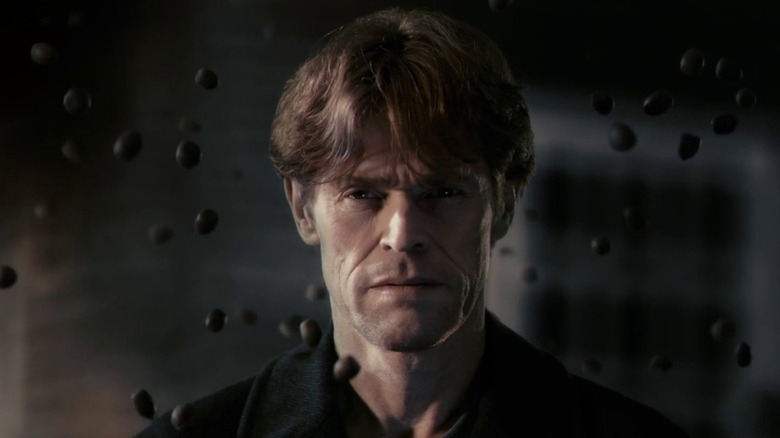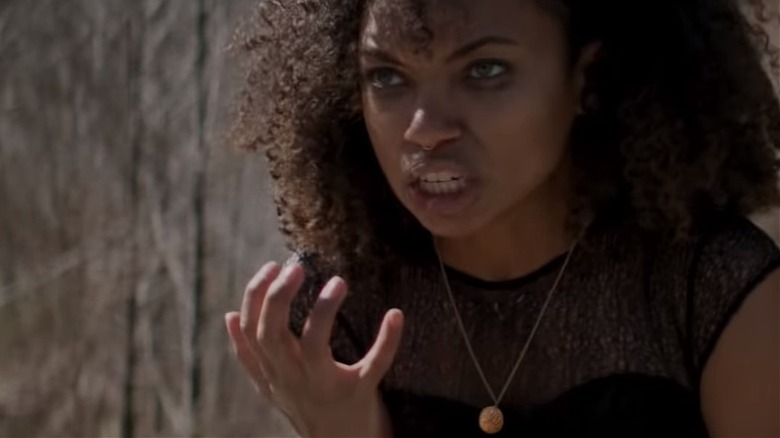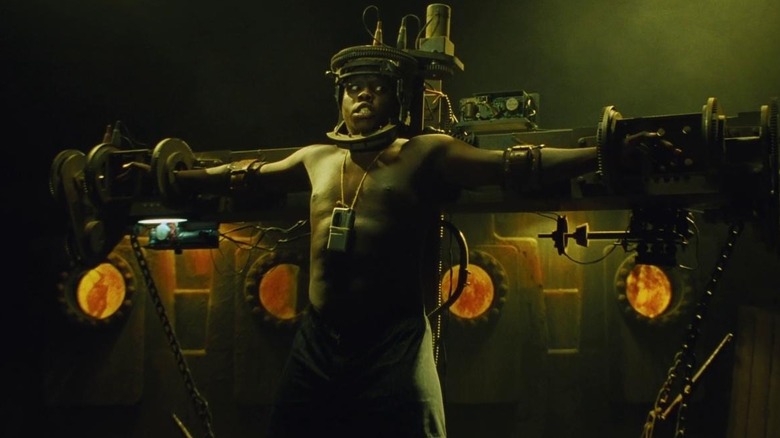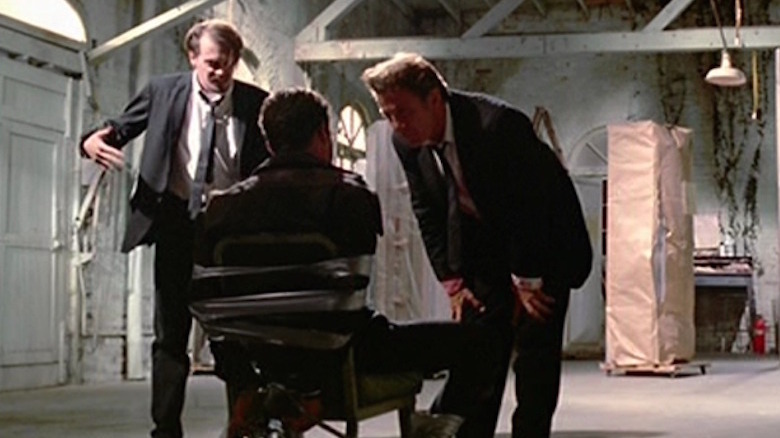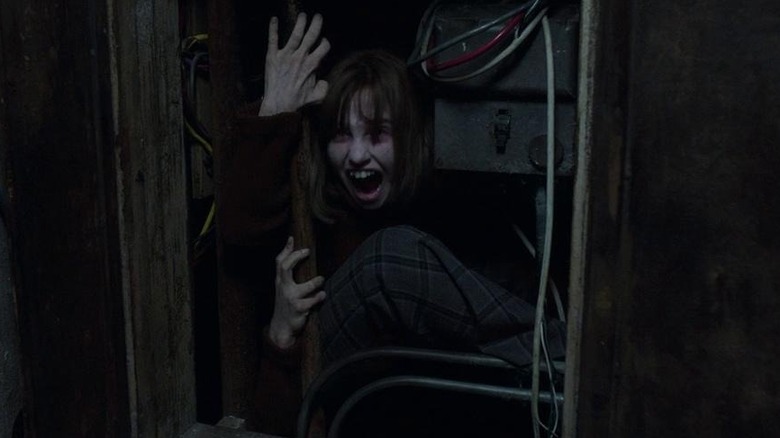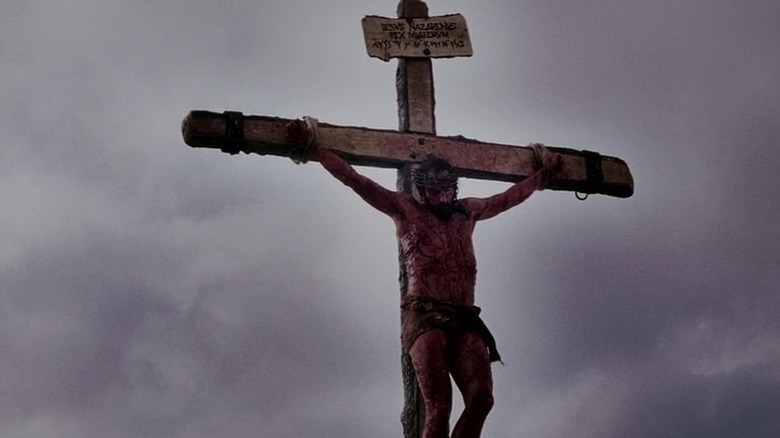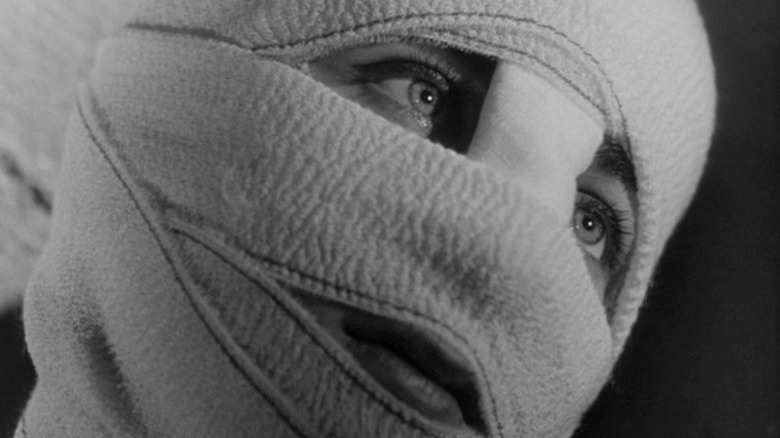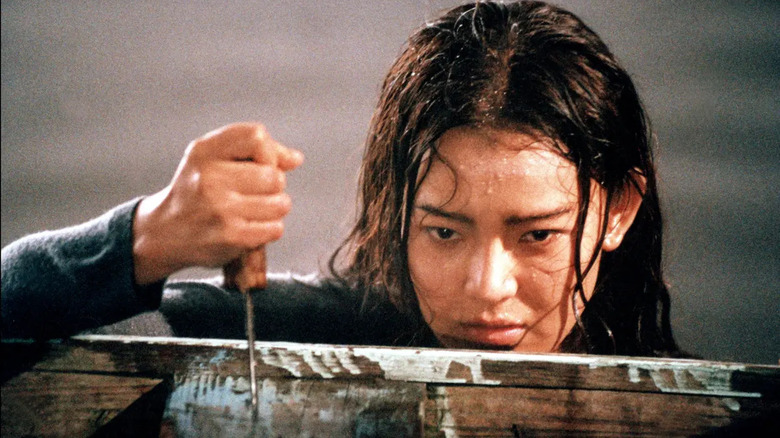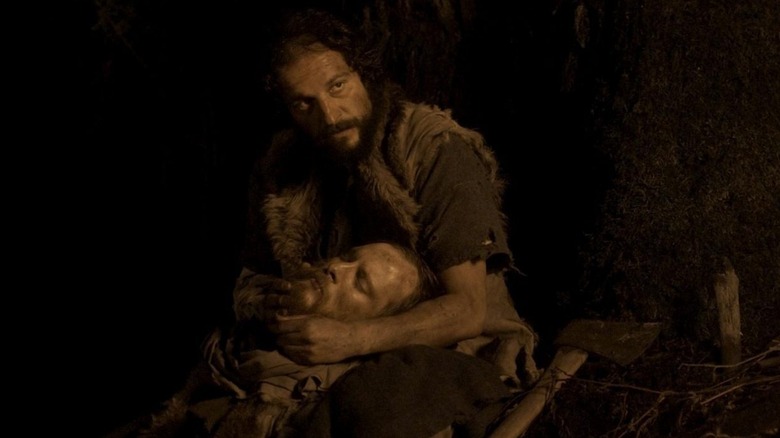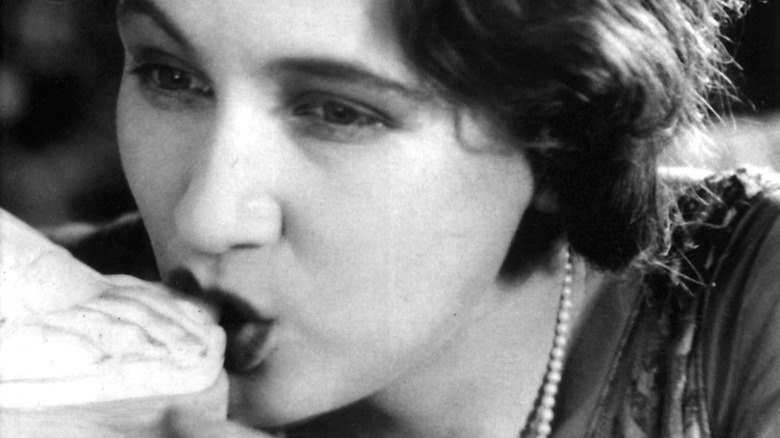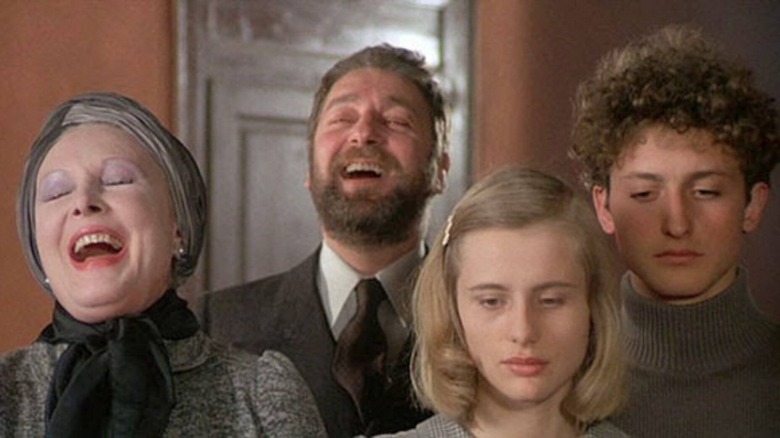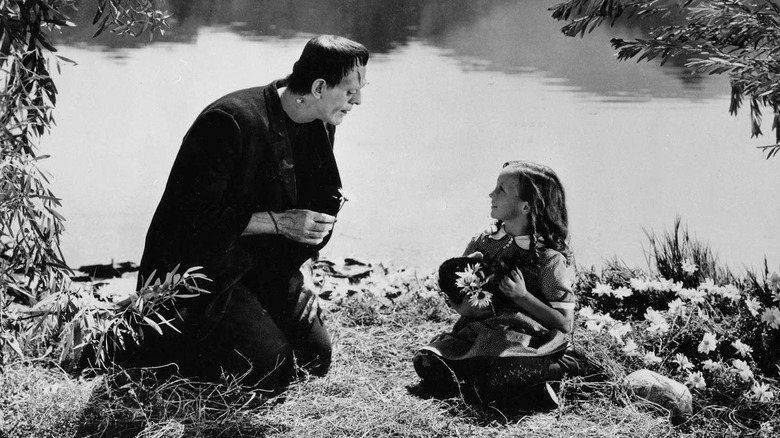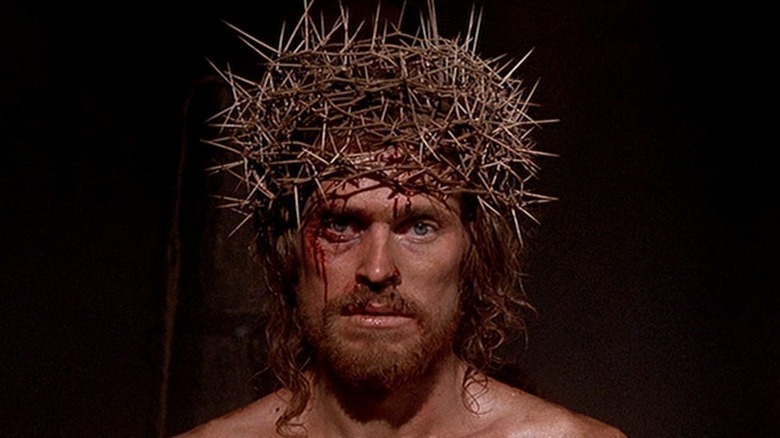Movies That Were Too Disturbing To Finish
We may receive a commission on purchases made from links.
Does the sight of blood make your insides turn? Do strange sex acts or domestic abuse send you running towards your theater's exit sign? Maybe you're extra sensitive to necrophilia or bodily mutilation, or maybe too many jump scares make you close Netflix and look for something a little more comfy.
Look, everyone has a weak spot, and there's bound to be a film out there that pushes one or two of your buttons. These movies, on the other hand, push all of them. These movies aren't just hard to watch. They aren't just edgy. They don't just challenge the entire concept of "good taste." They're deeply disturbing on almost every level — and some of them are downright vile. Many people can't manage to finish them, so if you've somehow managed to last through to these films' end credits, then you deserve congratulations of a sort. Either you've got an iron will, or you're indescribably depraved — or both. Seriously. Get help.
Veronica (2017)
Netflix's quick ascent to the top of the entertainment industry goes hand-in-hand with the rise of binge-watching. In fact, the company seems dedicated to trying its best to make sure that you never, ever turn off your television. That's what makes "Veronica" so surprising. In March 2018, Paco Plaza's Spanish-language horror film made headlines because people were so scared that they couldn't make it through the entire thing — and Netflix couldn't be happier.
Plot-wise, "Veronica" doesn't break any new ground. The title character misses her deceased father, her friend wants to talk to a dead boyfriend, and so the girls use a Ouija board and a solar eclipse to summon their spirits. As tends to happen when Ouija boards are involved, things don't go according to plan. If you've seen The Exorcist, Paranormal Activity, Ouija, or countless others, you know what to expect.
Or, at least, you think you do. Veronica succeeds where other films fall short through a mixture of real-life terror — "Veronica" is loosely based on a real-life story, although "loose" is an important part of that description — and pitch-perfect filmmaking. Plaza knows how to push all the right buttons, and that elevates a standard horror flick to what some people are calling the "scariest movie ever." After watching "Veronica," some viewers are plagued by nightmares for days. Others can only go to sleep with the lights on after watching — and those are just the people who finished the movie. Many don't make it that far. Life is short, after all. Why spend the rest of it cowering in fear?
Teeth (2007)
According to Forbes, Netflix has said that many of its grosser films will cause viewer dropoff. We're talking flicks like "The Human Centipede 2: Full Sequence," so gross that it was banned in Britain and in Australia. In fact, the copy of "Human Centipede 2" on Netflix is the cut and censored edition, meaning this movie is so bad that many people can't even sit through the "tame" cut. If the violence in 2016's "Cabin Fever" doesn't get you, the rest of the production probably will: it has a shockingly low 0 percent rating on Rotten Tomatoes. "Piranha" is both gratuitous and campy. "The Conjuring" is considered one of the best (and scariest) horror films in recent memory.
And yet, even among these shockers, "Teeth" stands out. In the film, Jess Weixler stars as Dawn O'Keefe, a Christian abstinence advocate who suffers from "vagina dentata" — or, to put it another way, she's got teeth down there. As such, the sex scenes in "Teeth" scenes aren't just uncomfortable. They're intentionally squirm-inducing, especially for the dudes in the audience. Combine that with all of "Teeth's" various depictions of sexual assault (as you might've guessed, it's a major plot point) and it's no wonder that few viewers last until the credits roll.
mother! (2017)
Darren Aronofsky's "mother!" sn't a traditional horror movie. It doesn't have any monsters or supernatural threats, and the whole thing feels more like a traditional allegory than other, schlockier entries in the genre. That doesn't make the film any less troubling, however. Love it or hate it (many people seem to choose the latter), "mother!" is successfully disturbing, thanks largely to the brutal and relentless abuse heaped on Jennifer Lawrence's character.
As "mother!" unfolds, you'll get to see Lawrence's poet husband, played by Javier Bardem, completely ignore his wife and her needs. You'll get a firsthand view as Lawrence fights to defend her home from hordes of her husband's ravenous fans. You'll watch as Bardem takes his newborn baby outside against his wife's wishes, and be forced to look on as the frenzied crowd kills it and eats it. When Lawrence protests, the crowd turns on her and beats her. By the end of the film, she's burned, battered, and dying — and then Bardem rips out her heart and the entire cycle starts again.
Taken all together, it's kind of a lot. Too much, in fact. Some critics found the film's graphic depictions of infanticide, cannibalism, and both physical and emotional abuse supremely distasteful. Audiences agreed. People flocked to the exits during "mothers!'" theatrical screenings, and we can't say we blame 'em. When a movie relies on a picture of a battered woman to get attention? That's a warning sign that you'd better not ignore.
Raw (2016)
Maybe you didn't complete a film because you decided to turn it off. Maybe you're simply too grossed out to stay in the theater. Sometimes, however, you don't have a choice. People didn't just walk out of "Raw," Julia Ducournau's cannibal thriller. They found the movie so disturbing that they passed out in the theater. Try finishing a movie while you're unconscious!
As far as "Raw" is concerned, it only takes a single scene to get everyone's stomachs a-heaving. When "Raw" begins, veterinary student Justine is a lifelong vegetarian, but she's forced to consume meat as part of a hazing ritual. As a result, she's consumed by a very specific hunger. A hamburger doesn't do the trick. Neither does raw chicken. It's only after Justine's sister, Alexia, accidentally cuts off her own finger and passes out that Justine finds the answer. Justine picks up Alexia's severed appendage and, after a few moments of hesitation, eats it.
For a couple of viewers at the Toronto International Film Festival, that was enough. At least two people passed out, forcing the festival to call an ambulance. Others fled to prevent vomiting. They weren't alone. When "Raw" screened at Cannes, a friend of director Julia Ducournau lost consciousness, while a row full of elderly patrons beat feet when Justine's odd case of the munchies took a dark turn. And that's just the beginning, too — Justine's cannibalism doesn't end with just a finger, and it's probably best for everyone that the more sensitive members of the audience didn't stick around to see just how depraved things get.
Caligula (1979)
According to the stories, Caligula, who served as Emperor of the Roman Empire from AD 37 to AD 41, wasn't a nice guy. He started famines on purpose. He slept with other men's wives and bragged about it later. He had an affair with one of his sisters and prostituted out the others. He threw orgies, spent money on bizarre and frivolous pursuits while his subjects starved, fed criminals to wild animals and had suspected political rivals humiliated or outright killed, depending on his mood at the time.
Sounds like a great subject for a movie, right? Bob Guccione, who founded the hardcore men's magazine Penthouse, certainly thought so. In 1979, Guccione released Penthouse's one and only feature film: "Caligula," a historical epic featuring Malcolm McDowell, Helen Mirren, Peter O'Toole, unsimulated sex scenes, and all different kinds of bodily fluids. Guccione might argue that "Caligula" is art, but everyone else seems to dismiss it as little more than a big-budget porno.
It's not just that "Caligula" s as depraved as its subject matter (trust us — "Caligula" has pretty much everything). It's also that there's just too much of it. With a runtime that borders on three hours, the movie requires a major time investment, and all of that debauchery gets exhausting fast. Acclaimed film critic Roger Ebert couldn't sit through it, and that guy saw almost everything. We doubt you'll fare much better.
The Great Ecstasy of Robert Carmichael (2005)
You could watch "The Great Ecstasy of Robert Carmichael" all the way through, but why? By all accounts, the film is thoroughly unpleasant. According to Variety, its second gang rape — yeah, there's more than one — "make[s] 'A Clockwork Orange' look like a Britney Spears video." When the sexual assault appeared onscreen, audiences had had enough. When the film screened at Cannes, the scene prompted a mass walkout. Given that one critic called "The Great Ecstasy of Robert Carmichael's" climax "a sequence excruciating beyond any in memory," we're going to bet that the Cannes showing wasn't the only time everyone bailed.
Not that the rest of "The Great Ecstasy of Robert Carmichael" is particularly easy to watch, of course. Even before young Mr. Carmichael goes full-on Alex DeLarge, he's not a likable character. By the time Robert becomes an ecstasy dealer (the title is a pun — get it?), he's more or less beyond redemption.
Oh, and by the way: the whole thing is supposed to be a statement on the Iraq war. During the first rape scene, which occurs offscreen, Robert is watching war footage on the local news. During the second assault, the film includes images of guns and bombings among the attack. That's how director Thomas Clay justifies "Robert Carmichael's" brutality: rape is used as a weapon in places like Iraq and Bosnia, he says, and he wanted the audience to feel "shocked and disgusted." Well, mission accomplished — but clumsy political commentary doesn't make "The Great Ecstasy of Robert Carmichael" any more tolerable. If anything, it just makes it even worse.
Hereditary (2018)
Writer-director Ari Aster describes "Hereditary," his critically acclaimed haunted house film, as a personal project. "I had gone through some stuff with my family," Aster said during a Q&A session. "I took my sickness and now put it inside all of you." Aster didn't elaborate further, but whatever the issue was, it must've been messed up. "Hereditary" isn't just the strongest debut from a horror director since "Get Out," it's one of the most terrifying films to come along in years — if you can manage to sit through the whole thing.
Not everyone can. While "Hereditary" received rave reviews when it screened at Sundance (at the time of this writing, it's got a whopping 100 percent rating on Rotten Tomatoes), it was also scary enough to drive many viewers from the theater. Even people who stayed for the whole thing didn't really want to. "I was tensely perched in my seat the entire time," Vulture's critic wrote, "ready to pick fight or flight just as soon as I could figure out what the threat was."
"Hereditary" isn't unsettling because of its jump scares or supernatural creatures, although it's got plenty of those. It's hard to watch because the characters' pain is so real. In "Hereditary," Toni Collette plays an artist, Annie, who just lost her borderline-abusive mother to cancer. Meanwhile, her relationships with her husband, her son, and her daughter are slowly deteriorating. That's enough to make "Hereditary" uncomfortable from the start. When the scares start dropping, it becomes unbearable.
The Wild Bunch (1969)
Sam Peckinpah's grim and gritty western "The Wild Bunch" might be considered a classic now — critics have compared it to no less than "Citizen Kane" — but during its initial run, the movie's hardcore violence was too much for late '60s moviegoers. Preview audiences lambasted the film, calling it "wasted insanity." After launch, cowboy king John Wayne complained that "The Wild Bunch's" blood-soaked action "destroyed the myth of the Old West."
Even by modern standards, "The Wild Bunch" is still grotesquely violent. In the '90s, Warner Bros. tried to release a director's cut with 10 extra minutes of footage. None of that new stuff was particularly gory. Still, the MPAA took the opportunity to change "The Wild Bunch's" rating from an R to an NC-17, keeping the film out of theaters for an extra two years.
"The Wild Bunch" is a movie that shows bullets puncturing human bodies in slow motion, features the deaths of hordes of innocent civilians, and includes a young child shooting an attacker in the back. It's brutal and uncompromising and, at the time, was too much for many theater attendees, some of whom walked out 20 minutes into the film. Just because "The Wild Bunch" is a classic doesn't mean that it's easy to watch. Even today, all of that bloody ultra-violence means that you might have to step away. Don't be ashamed. You'd hardly be the first one.
The Green Inferno (2013)
Director Eli Roth is no stranger to movies that are hard to sit through. His 2006 horror hit "Hostel" more or less invented the phrase "torture porn." With "The Green Inferno," however, Roth pushes things further than ever before — and unless you're a seasoned gorehound, chances are you won't make it to the end. In the grand tradition of the video nasties of the '70s and '80s, "Inferno" tells the tale of a group college-aged activists who head to the Amazon to protest a logging operation. They find cannibals instead.
You can probably imagine the non-stop stream of sadism, gore, and misery that follows, and if you can't last through the whole movie, well, that's kind of the point. In an interview with Rolling Stone, Roth said, "If I've really done my job as a director, nobody can actually watch your movie." He means it, too. "You don't want people walking out of a movie; you want them running out of the theater screaming," Roth elaborated. "When that happens, that's like a standing ovation for me."
Like "Cannibal Holocaust" before it, "The Green Inferno" achieves its unsettling dread by shooting on location in Peru, utilizing physical special effects, and casting members of the Amazon's native population in key roles. That's led some critics to (fairly) accuse "Inferno" of cultural appropriation, but Roth doesn't seem to mind. The amateur actors were all paid fairly, he's insisted, and while they didn't have much experience in front of the camera, "they got it right away and loved it."
Martyrs (2008)
Don't confuse "Martyrs," the 2008 French thriller, with its 2015 American remake. Both movies have roughly the same plot, but there's one big difference: for a story about child abuse, the English language version is remarkably tame. That's by design, writer Mark L. Smith told Creative Screenwriting. "I'm not a lover of violence," Smith said. "I tried to stay away from all the violence and keep it offscreen, which was kind of the polar opposite of the original."
So if you've got a low tolerance for abuse, watch that one. On the other hand, if you want to test your mettle, go for the original. With graphic depictions of child abuse, suicide, and murder, "Martyrs" isn't for the faint of heart. When it screened at Cannes, audiences left the theaters in droves. Producer Bob Weinstein, who's responsible for bringing movies like "True Romance" and "Pulp Fiction" to the masses, couldn't finish it — and his company bought the movie.
From the plot, which hinges on a series of girls who are kept locked up and tortured in an old slaughterhouse, to the film's climax, in which a young woman is flayed alive, it's easy to understand why. Sure, "Martyrs" is also a nuanced story about guilt and friendship, and Smith is right when he says that there's more to it than mere gore. But the gore is a big part of it. Like the New York Times wrote, this isn't one for amateurs. "When horror fans dare other horror fans to watch a movie," the grey lady opined, "it's 'Martyrs.'"
Irreversible (2002)
You won't find everything that makes "Irreversible" hard to watch onscreen. Don't get us wrong: Emotionally, the movie is absolutely brutal, thanks in large part to the 10-minute rape scene — one of two in the movie — and the frank depictions and discussions of incest, abuse, and murder. It's bad enough that even its star, Monica Bellucci, can't sit through it, even though she hardened herself on a diet of "The Accused" and "Deliverance" before filming (understandably, her father found it pretty hard to watch too).
But that's not the only reason over 250 people fled the film's Cannes premiere, with many fainting and seeking medical treatment. The sound played a big role, too. See, "Irreversible" uses infrasound, or low-frequency sound waves, to augment its unsettling visuals. You can't actually hear the sound, but your body registers it anyway, leading to feelings of anxiety, unease, distress, and depression, in addition to the shivers and, sometimes, nausea.
It's a trick that many modern horror films use, including "Paranormal Activity," and while infrasound doesn't affect every member of the audience in the same way, it's credited as one of the reasons why "Irreversible" makes many members of its audience feel sick. In fact, many people who watch don't even make it to the film's infamous assault. Thanks to the soundtrack, a mere half hour of "Irreversible" is more than enough for many viewers, forcing them to turn the film off before its most horrific action even truly begins.
The Woman (2011)
The best endorsement of "The Woman" comes from an anonymous audience member at the Sundance Film Festival, who left the theater while the movie was still running, and whose scathing review of Lucky McKee's horror movie happened to be caught on camera. "This is not humane," the man said. "This film ought to be confiscated, burned. There's no value in showing this to everyone."
An extreme view, maybe, but he's not alone. When "The Woman" made its Sundance debut, many people left the theater. Others simply wished they had. By all indications, that's exactly the type of reaction McKee was hoping for. The plot, which centers on a dysfunctional family's attempt to "civilize" a wild woman by locking her in the basement and torturing her, is explicitly designed to push every misogynistic and toxically masculine button. Heck, "The Woman's" distribution company sent out screeners of the movie packed in barf bags. Everyone involved knows exactly what they're doing.
Oddly, it's also a thoughtful and nuanced film, at least once you get past its surface shocks. It's not all gore and gloom. "The Woman" has something to say. It also has a pretty decent Rotten Tomatoes score, especially for this kind of thing. There's a rewarding experience lurking underneath the discomfiting chills — you just have to last through the whole movie to find it. Good luck.
The Angel's Melancholy (2009)
Is "Cannibal Ferox" too tame for you? Is "Human Centipede" a walk in the park? "Audition" is no big deal, and "I Spit on Your Grave" barely registers? If so, we've got good news for you. There's a new contender for the crown of the single most vile movie ever made. It's called "Melancholie der Engel," or "The Angel's Melancholy," and even if you've got a stomach made of iron and a will of steel, you may not make it through this one. If you're smart, you won't even try.
As for plot? "The Angel's Melancholy" doesn't need one. Oh, sure, there's some philosophical nonsense in there about a man who's decided that his life is winding down and wants to go out with a flourish — doing lots of drugs, raping teenage girls, killing animals, and indulging pretty much every sexual, scatological, masochistic, and beastialogical impulse you can possibly imagine, plus a few more.
Some nice cinematography aside, critics seem to agree that the main reason to watch "The Angel's Melancholy" is seeing whether or not you can last through it. "It is a depraved, perverse and nihilistic endurance test," Severed Cinema said in its positive review. "If anyone can sit through it all... I think that's pretty impressive by any standards," Cinema-Extreme's critic wrote. The Northern Light compared "The Angel's Melancholy" to sticking your face in a fire. "It will hurt all the time, it's just a matter of how much you enjoy the pain," it warned. "Stay away, stay far away."
Meet the Feebles (1989)
If you're bored, try this: invite some friends over, make sure they're relaxed, and then put on "Meet the Feebles." Don't tell them what's coming. Don't reveal that what starts as a low-budget Muppet knockoff quickly transforms into a puppet snuff film. Let your buddies discover that for themselves, and see how long it takes before everyone decides to shut it off.
Anyone who grew up with the Muppets will either find "Meet the Feebles" darkly hilarious or deeply disturbing. In our experience, there's no in between. Watching off-brand versions of Jim Henson's classic characters do drugs, film pornos, and deal with paternity lawsuits can be really funny. Sticking with the Feebles as they roofie each other, push through PTSD-fueled Vietnam flashbacks (including a Russian roulette scene taken straight from "The Deer Hunter"), and go on mass shooting sprees, on the other hand, is easier said than done.
Oh, and did we mention that "Meet the Feebles" was directed by Peter Jackson, the man who brought Middle Earth to the big screen and was responsible for the creation of Weta Workshop, the effects company that helped bring all of Tolkien's hobbits and orcs and elves to life? Yup, that's right. At some point, someone saw "Meet the Feebls" and thought, "Yes, these are the people we're going to give nearly $300 million and trust to make one of the most ambitious films of all time." "Meet the Feebles" may be too disturbing for many viewers to finish, but for Peter Jackson, it worked out very well indeed.
Revenge (2017)
Filmgoers at the Toronto International Film Festival should've known what they were in for. After all, its late-night "Midnight Madness" programming block has its name for a reason: anything goes. Unfortunately, not everyone got the memo, and one film fan found Coralie Fargeat's "Revenge" so intense that he had a seizure right in the middle of the theater.
Reportedly, it was a scene in which a man is forced to remove a giant piece of glass from his foot that did it. "We started to hear someone say, 'hello, hello,' from the audience," Fargeat told IndieWire. "I didn't know if it was someone making [a joke] in the room, then I see the paramedics in the cinema." Thankfully, the audience member was fine. He was in good company, too. "Revenge" lead Matilda Lutz admitted that the scene made her feel "weird" too. "And I shot it," she added, "so I can only imagine."
If that scene doesn't get you, the rest of "Revenge" very will might. Starring Lutz as a woman out for vengeance who's raped and left for dead by her lover and her friends — all of which is shown onscreen, naturally — "Revenge" is a lean, brutal, and extremely well-reviewed thriller that's just as thrilling as it is disturbing. Just don't take it lightly. If someone is willing to have a medical emergency rather than watch until the end credits, things must get pretty intense.
The House that Jack Built (2018)
Lars von Trier's been down this road before. In 2009, the director rolled into Cannes with "Antichrist." It's wildly misogynistic, contains multiple acts of genital mutilation, and is relentlessly bleak, and people walked out when it screened. It also scored lead actress Charlotte Gainsbourg a best actress trophy.
A decade later, von Trier did it again. After doling out a multi-year ban to von Trier after the director said he sympathized with Adolf Hitler, Cannes authorities decided to let the filmmaker exhibit his latest picture at the 2018 festival. Well, surprise! "The House That Jack Built" is even more difficult to stomach than its predecessor. Matt Dillon plays a serial killer on a 12-year murder spree. Along the way, he shoots two children in the head, gives a duckling an amputation with a pair of pliers, and engages in all other kinds of nastiness.
When "The House That Jack Built" screened, people left. Not just one or two, either. Reportedly, over 100 festival guests decided to leave the theater rather than finish watching Jack build his figurative abode. In the aftermath, attendees turned to Twitter to express their disgust, calling von Trier's movie "vomitive" and claiming that it "should not have been made." Fair criticisms, but they should've expected it. "The House That Jack Built" is so gross that it wasn't allowed to compete for the Palme d'Or, Cannes' top prize. Instead, it screened outside of competition in order to avoid any "Antichrist"-like controversies.
Goodbye Uncle Tom (1971)
"Goodbye Uncle Tom" (also known as "Farewell Uncle Tom," in case you're crazy enough to seek this one out) has a legitimately interesting premise. An Italian documentary crew travels back in time to explore the horrors of slavery firsthand. Despite directors Gualtiero Jacopetti and Franco Prosperi's background in schlocky "mondo" films — a.k.a. "Shockumentaries" — "Goodbye Uncle Tom" is supposed to be a serious anti-racist statement. Its terrors are even based on real historical documents, giving the whole enterprise a veneer of respectability.
But it's merely a veneer. "Goodbye Uncle Tom" is just as exploitative as Jacopetti and Prosperi's other work, and the real-life subject matter makes watching it more uncomfortable. Over its two-hour runtime, it bombards viewers with images of naked slaves being mistreated, beaten, raped, and sold. At one point, a 13-year-old sex slave tries to seduce one of the documentarians. He accepts her advances and has sex with her while the camera rolls. On top of it all, occasionally the movie slows down and gives its abused subjects brief moments of humanity. It's nigh-unbearable.
"Goodbye Uncle Tom's" behind-the-scenes history doesn't help. Jacopetti and Prosperi worked with Haitian dictator "Papa Doc" Duvalier, and were treated like his special guests. During filming, hundreds of anonymous Haitian extras were forced to suffer the same indignities as real-life slaves. It's cruel, shameless, and unabashedly racist, and it's been condemned by everyone from the Italian government to Roger Ebert to KKK leader David Duke. It's also hard to make it through the whole picture, although it's even harder to imagine why you'd ever even want to.
Bite (2015)
When horror fans entered the theater to see "Bite" at Fantasia Fest 2015, they received special Bite-branded barf bags. It wasn't a joke. As Fantasia Fest co-director Mitch Davis posted on Facebook, during the screening, at least two people passed out. One hit his head on the stairs. Another started puking. By the time the film wrapped, an ambulance was on site, treating various audience members for illness.
That's a pretty strong reaction, but on the other hand, "Boite" is a particularly gross movie. The horror begins in Costa Rica, where a bride-to-be receives a mysterious insect bite while celebrating her bachelorette party. Not that Casey has time to worry, of course. She's already struggling with her upcoming wedding, her domineering soon-to-be mother-in-law, and her fiancé's child-filled plans for their future. Like "Bites" audience, however, Casey underestimates the severity of her situation. Before long she's puking up pus, laying egg sacks around her apartment, raising a hive of carnivorous monsters, and watching as her body decomposes, revealing the insectoid form underneath.
In other words, "Bite" quickly shifts from middling character drama into full-on body horror, and as Fantasia Fest proved, it's not an easy movie to finish. First to Know said "Bite" explicitly "challenge[s] some brave souls to test their endurance." If that sounds like you, make sure you know what you're getting into first. Or, to put it another way: when a filmmaker says their movie will make you vomit, believe them. It's beats the alternative.
The Bunny Game (2010)
Many of the most disturbing movies share a similar setup: a man captures a woman, keeps her locked up in a remote location, and tortures her for the film's length. From that perspective, there's nothing particularly unique about "The Bunny Game." Behind the scenes, it's another story. Though the film was entirely improvised, star Radleen Getsic really was abducted and raped, and the movie is based on her actual experiences. Even worse? Aside from the drug use, everything that happens onscreen is unflinchingly real.
So, when Getsic appears on screen fully emaciated, she really is starving: the actress fasted for 40 days before shooting began. When her captor brands her with a red-hot iron, her screams are genuine. Gestic still sports the scars. During filming, Gestic was spit on, beaten, shaved, bound, gagged, and brutalized. Gestic was a consensual participant in the horror, but as a result, "The Bunny Game" toes the line between horror movie and actual snuff film, and it's not clear which side it ultimately falls on.
Accordingly, it's not an easy movie to finish. One blogger notes that she couldn't finish the movie in a single sitting. The Horror Society calls the movie "unwatchable," and says "you will finish it or you won't" — and that's in a positive review. Nobody's quite sure who Getsic director Adam Rehmeier made "The Bunny Game" for, but it's clear who it's not for: the faint of heart, and anyone with even a smidge of good taste.
Talk to Me (2022)
The embalmed hand of a dead medium that fuels the terror in "Talk to Me" also seems to possess powers that extend beyond the film's characters. Directors and siblings Danny and Michael Philippou, who made their feature film debut after earning a following with their horror and comedy shorts on YouTube, told Yahoo that the supernatural havoc wreaked by the hand had audiences reeling in their native Australia.
"People were fainting," Danny said in an interview with Yahoo. "It's happening in some of the screenings. One of the scenes is a bit intense. So people have been reacting, fainting." Though the brothers did not specify which scene was so overpowering, they did add that the movie was also too frightening for one crewmember to complete. "The person that made the hand, they quit after they delivered it," said Michael. "Apparently they had an uncomfortable experience with it the night before." The Philippous said that they apologized to the hand's creator, but it still wasn't enough to bring them back to the film. "They were scared," added Danny.
Terrifier 2 (2022)
Few movie promotional items drive home the idea that a movie experience will be intense more than a vomit bag. Movies ranging from "Mark of the Devil" to "Raw" gave away airline sickness bags to audiences to signal that the violence in those films would be so graphic that upset stomachs awaited. And while most of these efforts have been cheap but effective stunts, it appears that "Terrifier 2" actually justified their use.
When the horror sequel opened in October 2022, media outlets and social media accounts were flooded with stories of audience members fainting or becoming ill during screenings. The reports of such extreme audience response excited and alarmed writer-director Damien Leone. "Listen, I would have loved to have a couple of walk-outs," he told EW. "I think that's sort of a badge of honor because it is an intense movie. [But] I don't want fainting [or people] getting hurt during the movie."
Titane (2021)
The French-Belgian freakout "Titane" reaped a wealth of international awards following its release in 2021, including the Palme d'Or at Cannes and nominations for Best International Feature and Best Director for "Raw" helmer Julia Ducournau from the British Academy Film Awards, Cesar Awards, and other major film organizations. "Titane" also earned a reputation as a harrowing shocker, thanks in no small part to its depictions of brutal violence, sexual trauma, and otherworldly biological functions. A report from the 2021 Sydney Film Festival noted that these scenes caused fainting and walk-outs en masse during its premiere screening.
A statement issued by the Film Festival (via the Sydney Morning Herald) noted that 13 people fainted during the premiere screening, while interviews with attendees on the Australian media outlet Pedestrian.tv claimed that the actual number of faintings was higher and also cited incidents of panic attacks, vomiting, and walk-outs. These reports appear to have spurred the Sydney Film Festival's organizers to provide more detailed descriptions of films "so that audiences can make informed decisions," as Pedestrian.tv reported.
Freaks (1932)
Tod Browning's 1932 thriller "Freaks" remains one of the most controversial films — horror or otherwise — in motion picture history. The MGM release, which concerned a troupe of carnival performers who wreak terrible revenge on two of their members, eschewed special effects in favor of actors with real physical disabilities, including limbless performers Johnny Eck and Prince Randian, the Living Torso, conjoined twins Daisy and Violet Hilton, and microcephalic Schlitzie. Though Browning's film is essentially sympathetic to the sideshow talent, the sight of them in a horror-fueled scenario reportedly proved too much for some viewers and critics.
In "Hideous Progeny: Disability, Eugenics, and Classic Horror Cinema," author Angela M. Smith cited third-party accounts of negative audience reaction, including a Los Angeles Times article that claimed that during a test screening in California, "some horrified spectators got up from their seats and ran – did not walk – to the nearest exit." The article also quoted the film's production manager, who claimed that a woman tried to sue MGM because the picture reportedly caused her to miscarry. Such frightful press, real or otherwise, caused the studio to cut nearly a half-hour of footage from "Freaks"; the film, which will debut on Blu-ray from the Criterion Collection in 2023, exists only in this truncated form.
Goodnight Mommy (2014)
The 2014 Austrian horror film "Goodnight Mommy" hinges on a deeply unsettling notion: what if the person you love and trust the most proves to be an imposter? That's the situation faced in the film by twin brothers whose mother (Susanne Wuest) returns home after surgery a different person – changed not only in appearance but personality. The boys resort to increasingly horrible measures to determine this intruder's identity, but the brutality of their methods doesn't hold a candle to the truth behind the woman who insists they call her Mommy.
Directors Veronika Franz and Severin Fiala acknowledged that the violence in "Goodnight Mommy" was hard to watch, but also said that the gruesome scenes were more than just shock value. "I think if violence is grounded in something which is true to characters and to the world, it's important to show it in cinema," said Franz to Indiewire. Having said that, they were also pleased that the violence made a visceral impact on viewers. "Two people fainted," said Fiala. "That's the best compliment we've had so far."
The Exorcist (1973)
Though it's too soon to tell how audiences will react to "The Exorcist: Believer," there's a good chance that their response won't reach the heights of hysteria that accompanied the original film in 1973. When William Friedkin's adaptation of William Peter Blatty's novel about a case of demonic possession in modern-day Washington, D.C. hit theaters in late December of that year, audiences lined up in single-digit weather to see the spectacle of Dick Smith's astonishing special effects makeup for Linda Blair as the possessed girl. Many of them also freaked out.
Terrified audience members fled theaters and became physically ill during screenings; the New York Times reported incidents of heart attacks and even a miscarriage, while the Chicago press claimed that six individuals were committed to psychiatric care after seeing the film. The Times article also noted non-stop screaming during the exorcism, like the sound "one used to hear at early Beatles and Rolling Stones concerts." News and documentary footage from theaters in 1973 features interviews with audience members who made it through showings of "The Exorcist." Responses ranged from flabbergasted to something approaching shellshock.
Crash (1996)
David Cronenberg has made a career out of demolishing movie taboos and pushing the boundaries of subject matter with his unique body of work. While "Videodrome" and "Eastern Promises" stunned viewers with their depiction of violence, few of his films generated as passionate a response as 1996's "Crash." An adaptation of J.G. Ballard's novel about individuals who find fulfillment — sexual and otherwise — in car crashes, Cronenberg's film polarized viewers at the Cannes Film Festival, many of whom booed and walked out of the screening.
Even jury president Francis Ford Coppola seemed conflicted by his decision to award "Crash" with a Special Jury Prize. The New York Times quoted a statement from the "Godfather" director, who said that some jury members "did abstain very passionately" from awarding Cronenberg. The director appears to have retained his ability to shock audiences: "Crimes of the Future" was met with a seven-minute standing ovation at Cannes in 2022, as well as dozens of walk-outs.
The Blair Witch Project (1999)
While several movies have made (or claimed to make) audiences sick due to their bloody or disgusting content, a select few prompted viewers to run for the bathroom because of motion sickness. The most notorious of this wobbly group? "The Blair Witch Project," the 1999 found-footage thriller that purports to depict a documentary about a research project into a supernatural myth. Much of the film utilizes the herky-jerky aesthetic of handheld camcorder footage, which when combined with the film's heartstopping scares and claustrophobic framing, proved too much for some moviegoers.
CBS News reported on the near-constant wave of vomiting caused by "Blair Witch," with some theater managers stating that at least one audience member got sick at every screening of the film. "Blair Witch" wasn't alone in causing such mass outbreaks of puking; people bailed in droves on screenings of "Cloverfield" due to issues of motion sickness and migraines, while feelings of vertigo overcame audiences who saw "The Walk," Robert Zemeckis's 3D feature about highwire artist Philippe Petit's tightrope between the World Trade Center's towers in 1974.
Audition (1999)
Japanese rogue director Takashi Miike's 1999 shocker "Audition" seems almost built upon a formula designed to make audiences walk out. Grievous bodily injuries, including multiple acts of dismemberment? Check? Needles inserted in places they should never go? Done. Consumption of bodily waste? Affirmative. And a near-trick ending to boot? All of that — and much more — is on vivid display in "Audition," which generated a hostile reaction from some viewers at various screenings.
Actually, that's not entirely true. When "Audition" played at the 29th Rotterdam International Film Festival in 2000, it was showered with praise and awards, including the FIPRESCI Prize for best film and the KNF Award from the Circle of Dutch Film Journalists. Not everyone was as enthusiastic, however. Far from it, in fact: Vulture noted that the screening was also beset by walkouts, including one audience member who called Miike evil as she exited the theater.
127 Hours (2010)
While most of the films on this list sent a handful of viewers in select locations to the restroom or even to the hospital, Danny Boyle's "127 Hours" caused audience members to drop like flies in multiple places. The film, released in 2010, detailed the plight of hiker Aron Ralston, who was forced to amputate his own arm when it became trapped under a boulder. Boyle unflinchingly depicted the amputation, and reactions were extreme.
A story in the Los Angeles Times addressed the scene's impact on audiences at various film festivals and screenings across the country: six people collapsed at one fest, while others reported extreme nausea, dizziness, and even an apparent seizure. The real-life Ralston told Entertainment Weekly that he attended several screenings at which audience members passed out, while Boyle told The Moveable Feast about a special screening at Pixar Studios that went awry. "There were people lying down on the steps of Pixar and this one woman, I was looking at her and she woke up and she recognized me and she said, 'Oh, good film,'" he explained.
Kuso (2017)
The surreal 2017 film "Kuso" generated some of the most polarized responses from critics and audiences in recent memory. The brainchild of music producer/DJ Flying Lotus (a.k.a. Steven Ellison), "Kuso" has been labeled "the grossest movie ever made" by The Verge, and "a film so off-putting and/or upsetting you wish could take your eyeballs out and scrub the experience from memory" by Variety. And if those reactions sound like hyperbole, how else would you describe an anthology-style collection of shorts set in a post-apocalyptic Los Angeles awash in excrement, bodily fluids, sentient boils (and sex acts involving them), and the sight of a giant bug emerging from funk pioneer George Clinton's rear end?
Sundance Film Festival goers in 2017 apparently agreed with the critical assessment of "Kuso." Attendees of a midnight screening reportedly walked out after just 10 minutes, according to Variety reporters. Flying Lotus later dismissed the idea that the audience fled en masse: "It was only like 20 people out of like 400 who walked out," he wrote on X (formerly known as Twitter), adding, "I tried to warn folks."
Antichrist (2009)
Few films have divided audiences like Lars von Trier's 2009 film "Antichrist." While the surreal drama reaped a Palme d'Or nomination and Best Actress Award from the Cannes Film Festival in 2009, it also earned a special "anti-award" from the festival's ecumenical jury for "the most misogynistic movie from the self-proclaimed biggest director in the world." Critics were also split about "Antichrist," with positive reviews balanced by true critical bile, the most amusing of which was Variety's assessment of the picture as "a big fat art-film fart" (really).
However, this divide paled in comparison to reactions from the Cannes audience, which outdid itself in adhering to the festival tradition of loudly booing disliked films. Out-there moments like its notorious talking fox were met with laughter, while scenes of genital mutilation and physical abuse elicited audible gasps. According to the Guardian, at least four attendees also fainted due to the film's graphic content.
The Perfection (2018)
In the Netflix horror film "The Perfection," Logan Browning endures one of the most gruesome scenes in recent movie history. While traveling with fellow musician Charlotte (Allison Williams) through China via bus, Lizzie (Browning) becomes violently ill and spews up what appears to be a mass of maggots (in a nod to Chinese horror films like "Black Magic"). The horrible stomach distress and voiding of maggots goes on for what feels like an eternity, which left many viewers feeling as nauseated as Lizzie.
An interview with Wiliams in People included posts on X (formerly known as Twitter) from viewers who found themselves becoming ill while watching "The Perfection." X user @/Linzi Saurus wrote, "Just watched The Perfection on Netflix and felt sick pretty much the whole way through. Gory and disgusting." X user @/Tala reported feeling a lot like Lizzie after her screening: "The perfection on netflix is SICK... in a bad way ugh my body can't move and I feel like puking." Well, that's one way to gauge viewership.
Saw III (2006)
Critics delivered a mediocre response to "Saw III" in 2006, but audiences turned out in droves to the third entry in the long-running horror franchise: "Saw III" is the highest-grossing entry in the series worldwide, with a total box office take of more than $164 million. However, some audience members in the United Kingdom got too excited about the film upon its release there in October 2006.
The BBC reported that three separate calls to emergency services were made in a single night during a Friday night screening of "Saw III" in Stevenage, a town north of London. Two audience members were treated by medics after fainting and released to "friends and relatives," but a third, a woman in her 20s, was brought to the hospital and later discharged. "Saw III" also reportedly caused a fourth individual at a different theater to collapse during a screening. A spokesperson for the East of England Ambulance Service who was quoted in the BBC item seemed to sum up the basic rule of thumb regarding violent horror movies: "If you know you're squeamish, don't go," said the spokesperson.
Reservoir Dogs (1992)
Quentin Tarantino got an education in audience reaction when he took his 1992 crime thriller "Reservoir Dogs" on the festival circuit. The Guardian quoted Tarantino's speech at an anniversary screening of the film at the Tribeca Film Festival in 2017, where he recalled festival audiences finding it hard to stomach its gory violence. "They read the program and hear a synopsis and that's it, so it's understandable that at a film festival that maybe this is not what they want to see and they have to leave," he said (via EW.com). Tarantino reported counting 33 people walking out of one screening.
When "Reservoir Dogs" screened at the Sitges Film Festival, Tarantino said he thought it would earn a more positive reaction; Sitges is, after all, devoted to fantasy and horror films. "Finally, I've got an audience that won't walk out," he recalled thinking. Unfortunately, five people headed for the exit at the Sitges screening, including director Wes Craven, a filmmaker known for uncompromising horror films like "The Hills Have Eyes." "The guy who did 'Last House on the Left,' my movie's too tough for him," said Tarantino.
The Conjuring 2 (2016)
A screening of "The Conjuring 2" in India turned into a real-life horror movie after an audience member reportedly died while watching the Blumhouse supernatural thriller. A news item in the Times of India in 2016 claimed that a man attending a screening of "Conjuring 2" in the southern Indian town of Tiruvannamalai complained of chest pains before fainting. The 65-year-old was rushed to a nearby hospital where doctors pronounced him deceased. And that's where the story gets even weirder.
Hospital staff reportedly asked the man's companion, who also attended the film, to take the body to the Tiruvannamalai Government Medical College Hospital for a post-mortem examination. The body never made it to the facility: both the friend and the dead man were reported as missing, and local police conducted an investigation to determine both the cause of the disappearance and the possible whereabouts of both man and corpse.
No additional details about the case have surfaced since 2016, but the news item kicked off a minor social media storm about the film's dangerous potential, including a video on Facebook that allegedly showed a woman becoming possessed while watching "Conjuring 2." However, the video was debunked after reports surfaced that it had actually been filmed in 2013.
The Passion of the Christ (2004)
Instances of movies being so grueling to watch that they sent people to the hospital are few and far between, and even rarer are deaths caused by a motion picture experience. Rarest of all is the movie that caused more than one death, but Mel Gibson's "Passion of the Christ" can actually lay claim to that title. The 2004 historical drama, about the final days of Jesus, features harrowing scenes of torture and violence that proved so distressing to two viewers that it killed them.
Peggy Scott, a 56-year-old native of Wichita, Kansas, saw the film at a special screening sponsored by ClearChannel Radio in February 2004. According to Reuters, Scott experienced an apparent heart attack during what a spokesperson for Wichita's KAKE-TV described as "the highest emotional part of the movie." Scott was transported to a neighboring hospital and later pronounced dead. No further details on the cause of death were reported, but a month later, the BBC reported that Jose Geraldo Soares, a Presbyterian minister in Bel Horizonte, Brazil, died during a screening of "Christ" which he had organized for his congregation. His wife, who was also in attendance with their two children, noted that Soares was not responding to her; a doctor in the audience confirmed that the minister had died of a heart attack.
Eyes Without a Face (1959)
If you still believe that black and white horror movies aren't scary, it's time for you to see "Eyes Without a Face." The French film, directed by Georges Franju and released in 1960, is a foundational title in the "surgical horror" subgenre and concerns a doctor determined to correct his daughter's facial disfigurement. His intention is pure, but his methods — well, let's call them unsound. He and an assistant kidnap young women, removing their faces and grafting the skin onto his daughter. Unlike many films of the period, Franju spares no detail in showing the surgery in all its bloody glory.
Audiences in 1960 weren't prepared for such graphic gore in any film. Herschell Gordon Lewis's "Blood Feast," widely considered the first full-gore horror title, was still four years away. Reports about "Eyes Without a Face" from the Edinburgh Film Festival noted that seven people fainted during a screening. Franju reportedly responded by stating, "Now I know why Scotsmen wear skirts" (via TCM). Trimmed for American release, "Eyes Without a Face" was largely dismissed by mainstream critics and didn't earn its reputation as a horror classic until years later.
The Isle (2000)
The late director Kim Ki-duk's body of feature films earned critical praise around the world for their unique blend of contemplative imagery and ideas and explosive, often gruesome violence. His work has received major awards from festivals, including the Un Certain Regard from the Cannes Film Festival for his documentary "Arirang" in 2011 and the Golden Lion for "Pieta" from the Venice Film Festival in 2012. However, the 2001 drama "The Isle," his first film to screen for international audiences, received a very different reaction from viewers.
An uncomfortable, intimate look at a very complicated relationship between two loners, "The Isle" featured several scenes that shocked festival audiences to their cores. Images of frogs and fish being skinned and carved up were disturbing, but the coups de grace for most audiences involved fishhooks being swallowed by one character and inserted into another. EW reported incidents of fainting at the Venice Film Festival due to these scenes, while Brooks Atkinson of the Village Voice echoed accounts of "fainting spells and vomiting seizures" at New York screenings. Roger Ebert, giving his account of the film's debut at the Sundance Film Festival, noted audible gasps and walk-outs.
Van Diemen's Land (2009)
The 2009 Australian historical thriller "Van Diemen's Land" is based on the real-life case of Alexander Pearce, an Irish convict sentenced to a penal colony in Van Diemen's Land (now Tasmania) in the early 19th century. Pearce and several other prisoners escaped the prison but harsh conditions forced them into starvation and cannibalism. Pearce, the only survivor, was hanged in 1824 and remains a controversial figure in Australian culture to this day.
Pearce and his fellow escapees were the subject of "Van Diemen's Land," which sought to view his actions through the lens of a desperate act of survival and not homicidal mania. Director Jonathan Auf Der Heide, who frankly depicted the murders and cannibalistic acts, was shocked to discover that audience members had become physically ill and even passed out during screenings.
"The vomiting thing is a real surprise to me," said Auf Der Heide to AAP (via The Sydney Morning Herald). "But [the movie is] nowhere near as intense as a lot of the cinema that's out there today because we did shy away from the gruesome stuff. What people find so gruesome about it is that it is approached as authentically as possible."
L'Age d'Or (1930)
Director Luis Buñuel and artist Salvador Dali's first film collaboration, the seminal surrealist short "Un Chien Andalou," failed to generate the sort of angry controversy the anarchic pair hoped to stir up. Even with images of eyeball slicing, severed hands, and priests trailing dead donkeys, the art world elite adored the film, which prompted Buñuel and Dali to try and rile up the bourgeoisie again. Their second collaboration, 1930's "L'Age d'Or," skewered society's efforts to repress sexuality through a torrent of startling images, including allusions to the Marquis de Sade (the producer's wife was a direct descendant) and images of child murder and exploitation, sexual obsessions, animal death, and a woman doing something unseemly to the toe of a statue.
This time, Buñuel and Dali got the response they wanted. Several days after its premiere, members of the Fascist League of Patriots caused a riot at Studio 28, where the film was screening, possibly due to beliefs that the filmmakers were Jewish or aligned with Communists. Reports of the riot vary on the level of violence, which may have included fights with other audience members, destruction of art by Man Ray and Dali, in the lobby, and the use of smoke bombs and tear gas. "L'Age d'Or" was subsequently banned by French censors and remained out of wide circulation until the film's U.S. premiere in 1979.
Saló, or the 120 Days of Sodom (1975)
Any list of the most shocking and disturbing films ever made must include 1975's "Saló, or the 120 Days of Sodom." The World War II-era drama, directed by Italian filmmaker Pier Paolo Pasolini, is a savage indictment of power and corruption: the abusers here are political, legal, and religious figures in Fascist-occupied Italy who subject a group of teenagers (including their own children) to nightmarish physical and sexual abuse before slaughtering the majority of them. Though Pasolini's sympathies appear to be with the victims, he also does not flinch from depicting their torture and degradation.
Numerous countries banned "Saló" and it remains a divisive subject for audiences and critics nearly five decades after its release. While many film writers praise Pasolini's vision, others find it too bleak to recommend or even endure. Variety critic Peter Debruge supported those who walked out of the film, stating, "'Saló' holds no reward for viewers who keep their seats to the end. To walk out on the film is to triumph over the impulses it critiques; to pause, rewind and zoom, by contrast, is to fall prey to that very nature."
Frankenstein (1932)
Universal Films' adaptation of "Frankenstein" became a cultural touchstone, influencing everything from television shows and pop songs to breakfast cereal. But the ubiquity of the character, and Boris Karloff's performance as the Monster, also dampened its effectiveness as a horror movie. It's hard to believe that at one point, movie audiences were terrified by this film. And in some cases, they were frightened enough to flee the theater.
David Skal's invaluable book "The Monster Show" quotes an interview with film producer David Lewis, who was also "Frankenstein" director James Whale's partner. Lewis recalled a preview of "Frankenstein" in Santa Monica, California, that generated a near-stampede for the exits. "As [the movie] progressed, people got up, walked out, came back in, walked out again. It was an alarming thing." Response to "Dracula," Universal's other touchstone horror film from the same year, appears to have been milder. Though Universal's press machine issued statements that suggested that viewers were fainting during the film, no proof of such incidents has ever been uncovered.
The Last Temptation of Christ (1988)
Most of the people who took issue with Martin Scorsese's adaptation of "The Last Temptation of Christ" in 1988 refused to see the film, preferring instead to protest outside theaters (or completely shut down Los Angeles traffic, as 25,000 people did during a protest at Universal Studios that year). There were also extreme reactions, like the arson attack on a French theater showing the film that left 13 people hospitalized. But it also generated walkouts, most notably religious leaders in Los Angeles and Washington, D.C. invited to special screenings.
A handful of invitees left the showings before the final credits, including the Reverend Frank Eiklor, whose decision to leave was motivated by the film's dream sequence which depicted Jesus as a normal man. "I see why Universal waited until the last day (before the nationwide premiere) to show this film to us," he said. "When you see Jesus portrayed this way, when you see Jesus Christ made the wimp, I could only walk out outraged."
